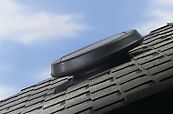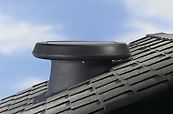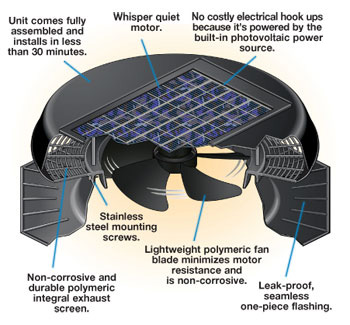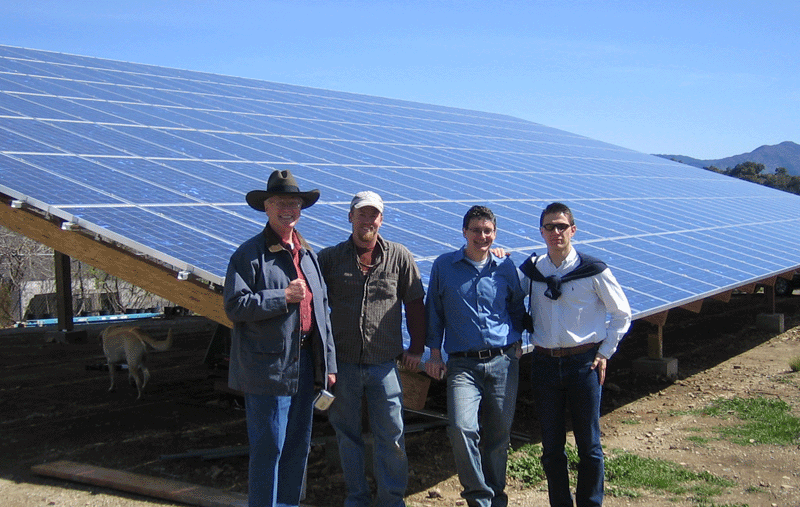
Solar Attic Fans
an Ideal Solar Application
(no batteries needed)


|
Solar Attic Fansan Ideal Solar Application(no batteries needed) |

|
(2009 Feb blog post)
! Note !
Some more links and pricing information may be
added in the future, if I re-visit this page.
|
INTRODUCTION In 2005, I decided to replace several attic fans in our house with solar attic fans. I had always been drawn to the idea of replacing more and more of my electricity use by 'alternative', non-carbon-burning (and non-nuclear-fission) means of electricity generation. In this case, I was driven to action because one of our electric attic fans froze up. I heard some ugly wailing sounds coming from the attic over our garage. I found that the fan was 'frozen up' or freezing up --- probably bearings going bad. (I forget whether the circuit breaker tripped to bring an end to the wailing. I think I was lucky to be home at the time to track down the source of the noise.) In any case, I decided now was the time to look into solar attic fans. I had seen ads for them occasionally in local advertisements --- and in solar energy magazines on news stands. I decided to check out models and prices on the internet and found sites like the following.
In case those sites go dead, you can try a WEB SEARCH on keywords 'solar attic fan'. |
|
Price In 2005, the price per fan was about $325. That was almost 10 times the cost of an electric model with a thermostatically-controlled on-off switch. But the savings in electricity costs were projected to result in a break-even point in a few years. I called a local contractor and found that his price was compatible with what I saw in internet searches. I went with his brand, the Solar Star brand. I may have lucked out. The young installer was friendly, seemed conscientious, and did a good job. (How often does that happen?) Number of fans replaced I have a rather complex roof --- three separate attics --- which had three separate attic fans. At first, I planned to have two installed --- just in case the fan did not work out as I had hoped. But the installation was going well, and the fans seemed to 'kick right in' on that sunny day, so I had the third electric fan replaced. It would have cost extra to remove the old electric fan and install the solar fan in its place. Since I wanted to keep the electric fans in place, in case the solar fans failed, I went with the less expensive installation option --- 3 separate, new holes in the roof. (After the installation of the solar fans, I made sure the old electric fans were turned off.) I figured if the attic fans worked OK for a few years, I might have the three electric fans replaced with solar fans. It was surprising how quickly the installer could cut a hole in the roof and install each attic fan. As part of the installation, this company inspects the rubber boots around pipes that vent through the roof. I had a couple of boots replaced, which added somewhat more than $100 to the total bill --- which was somewhat north of $1,000. |
|
Pleased After several hot summers of operation, I can say that I am quite pleased. It is a real pleasure to check on one of the fans in the early morning as the sun is coming up and see the fan slowly spinning. Then, at mid-day, the fan is spinning in a blur. And even at sundown, it is still spinning at a good pace. The first time I did that check was when it really hit me that this is the perfect solar application. The fan starts spinning as the sun comes up --- spins fastest at the hottest time period of the day --- and slowly shuts down as the sun goes down. No batteries required, and it spins fastest when you need it the most. With the old thermostatically-controlled attic fans, most of the time, when I went in the attic in the summer, the heat was almost unbearable. Even if the electric fan was running, it was having a heck of a time expelling the heat that had built up when the fan was switched off. With the old thermostatically-controlled attic fans, the attic temperature never got down to a comfortable level in the summer. It was always stifling in the attics. In contrast, with the solar attic fans, even on the hottest summer days, the temperature was quite tolerable when I had to spend quite a few minutes in the attic. I can imagine that if I had a thermograph plotting the temperature in my old electric-fan attic, that the graph would look like a saw-tooth, with the peaks reaching over 110 degrees. Those temperature extremes were probably not helping the life of the asphalt roof shingles. In contrast, whenever I would enter one of the attic spaces in the summer months, after the solar fans were installed, the temperature was always bearable --- probably in the 90's in the middle of the day. |
|
Noise and Heat Reduced We have a two story house and I use an upstairs room as a computer room. It used to be that the noise of the electric attic fan above me was quite loud. (That was a main reason I had that attic fan replaced with a solar one, even though it was not the one that bound up and wailed.) It appeared to me that the heat levels in that upstairs room, after installation of the solar attic fans, was less variable, and the temperatures were more comfortable. (I have no good way to assure that this was the case. It would be rather difficult to prove, since the temperature there is also a function of how well the air conditioning system is pumping cool air into the room during the summer. But it did seem that the room was not going through the rather mild extremes of temperature that it went through with the electric attic fans, especially whenever the air conditioning had switched off for a while.) Electricity usage It would be hard to determine if there was a significant effect on our electric bill, since our electric use is dominated by electricity use for
The electricity use of the attic fans, although heavy for almost half of a year, was probably less than 3% of the total electricity usage --- well within the annual electricity-load fluctuations of the house. At the end of the [sunny] day, I can say that I probably get more satisfaction out of the absence of temperature extremes and the absence of noise from the electric attic fans, than I would get from any electricity-bill savings I might be able to calculate. The initial cost was high compared to replacement with traditional electric attic fans. But the sweet feelings I get, year-upon-year, make it all worth that initial cost. Durability I was concerned about how long the solar attic fans would last. They have been through several hot summers now. I have my fingers crossed. So far all is quite sweet. |
|
If the fans themselves fail, the top of the assembly is removable. The fans can be replaced without moving the base of the unit. As for the solar-cell wafers, they will probably last many years (unless damaged by hail, which we haven't had here in over 20 years). I have read of solar wafers used on lighting-buoys at sea lasting many years. So I think the fans are the most likely first point of failure. Next would be probably be the cells. The solar-cells are on the top of the unit. So if I replace the fan, I will be replacing the solar cells. If a fan fails, that would probably be a good time to replace the solar cells. Less Fire Hazard One other reason I wanted to go with solar attic fans instead of traditional electric was the fire hazard. After experiencing a house fire in 2003 (in our garage), I did not want to go through that again. I had always been concerned about a electric fan freezing up and casting sparks on flammable materials --- like the wrapping paper that my wife keeps in the attic. She simply will not keep it covered up, no matter how many times I plead with her. With the attic fans, I feel there is a much lower likelihood of a fire hazard. I do not think there is much likelihood of a significant amount of sparks being thrown off by a solar attic fan if the fan 'freezes' up. [The driving power of the solar-powered attic fan does not seem to be as intense as that of the traditional, utility-company-powered electric fan.] This greater-fire-safety-feeling is one more sweet feeling to add to the list. |

|
Auto-start at sunrise --- sweet! In summary, I can say that it is a sweet feeling to know those fans are perking up every morning as the sun comes up. The fans awake like early-birds. And those fans are like ultra-marathon runners --- they run all day without rest. Furthermore, it is great to go up into the garage attic in the middle of summer and NOT be hit by a furnace-like wall of heat. |
|
No batteries needed And not needing batteries, for energy storage, is a plus. I was describing this 'perfect application' of solar energy to a couple of guys one time, and one of them kept making comments about the batteries. I couldn't seem to get through to him that there are no batteries required in this application. 'No batteries needed' makes for another sweet feeling. Celebrities with bigger solar installations I want to keep watch on people like Larry Hagman (former TV star on the 'Dallas' series) and Ed Begley (movie and TV actor) who have solar installations for their houses. I saw Hagman interviewed around 2006, after he had installed a large solar panel installation on his ranch to provide a major part of his electricity needs. At the end of the show, he had his feet up on his front porch and had a big grin on his face as he talked about how his solar panels were 'humming away', generating electricity while they sat there. I want to see if Hagman and Begley are still satisfied with their installations several years after the installations --- if they still use them --- and if they have modified them. Distributed versus centralized energy generation I hope to have that Hagman-feeling someday. I think it would be great to have a 'largely distributed' electricity generation system throughout this country. It would be more fail-safe than central power plants. Kind of like the internet is a world-wide distribution of computer power --- with hardly a single point of failure. A largely decentralized power system may be more likely in a place like Africa. Kind of like they are skipping the telephone line intrastructure path and going with cell phones --- many African countries may end up with very few coal/oil/nuclear-fueled central power plants and use wind-solar-geothermal-ocean energy sources. I plan to post more comments and info on those types of issues and concepts, in other energy blog posts on this site. |

Larry Hagman has a big installation. Note that there are
about 8 rows of panels and over 30 panels per row, for a total
of more than 240 panels. A typical residential house should require
about 30 to 40 panels to handle most needs --- with some flow into
the grid at times of excess generation and some flow into the home
from the grid at times of excess electricity usage.
This picture was probably taken in the 2000-2005 time frame.
Sadly, Hagman passed away of cancer in 2012.
I still (in 2013) have not found info on how his system was
performing about 5 or more years after installation.
But in early 2013, I saw a TV news report on a school system in
California that went solar and was saving a bundle in energy costs.
Hopefully more school systems, all over the country, will find that
this is a good way to reduce their costs significantly and thus
reduce the adverse effects of budget squeezes. I would like to
see a follow-up report on their solar installation, around 2016.
Here (at cnn.com) is a link to a 2011 story on solar in
California schools of the San Ramon Valley Unified School District.
And
here (at latimes.com) is a link to a 2012 story on solar
in Los Angleles schools.
In case these links go dead,
here is a link to a WEB SEARCH
on keywords 'california school solar panels'.
|
Bottom of this page on
To return to a previously visited web page location, click on
the Back button of your web browser, a sufficient number of times.
OR, use the History-list option of your web browser.
< Go to Top of Page, above. >Or you can scroll up, to the top of this page. Page history:
Page was posted on 2009 Feb 23.
|